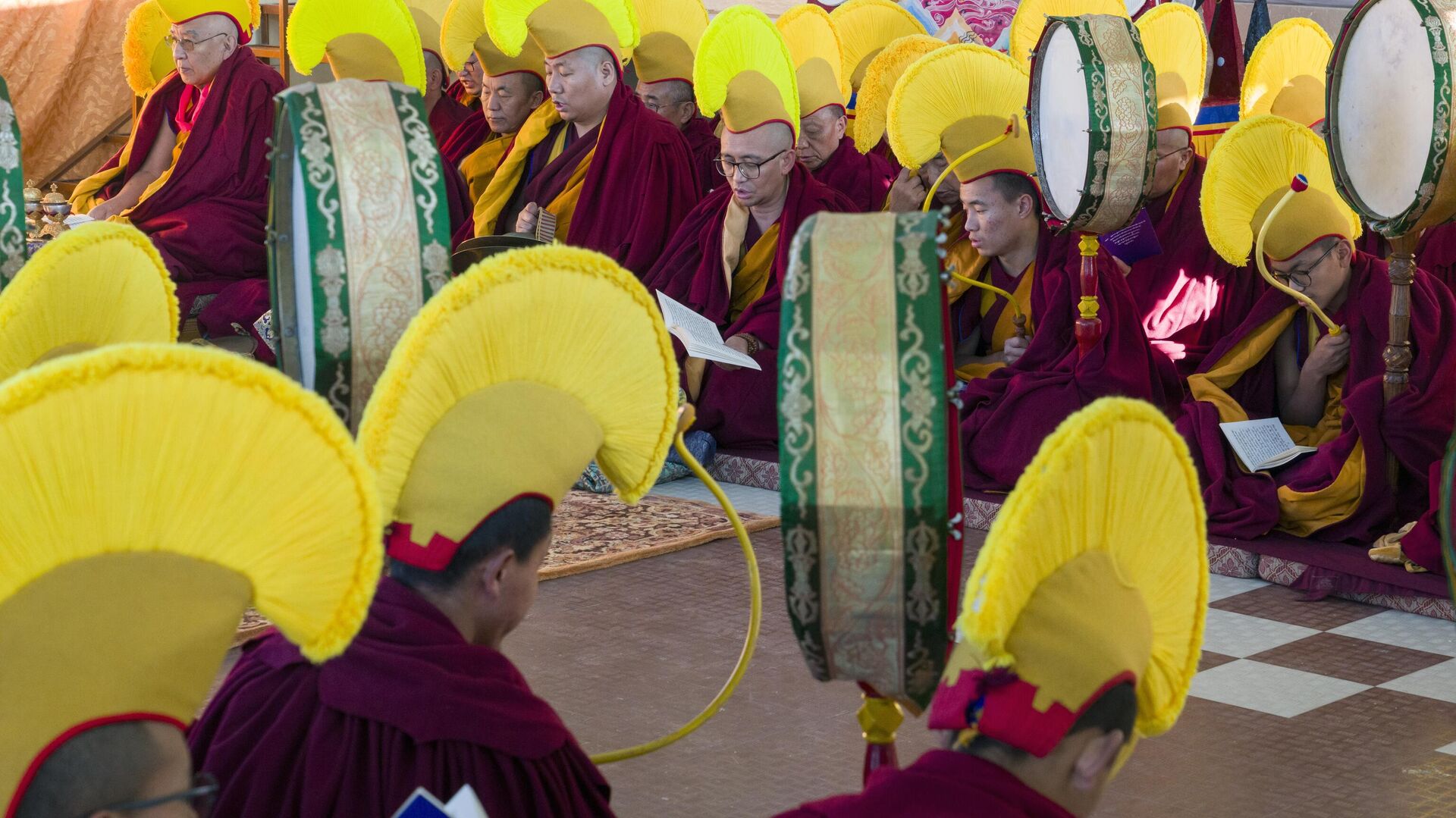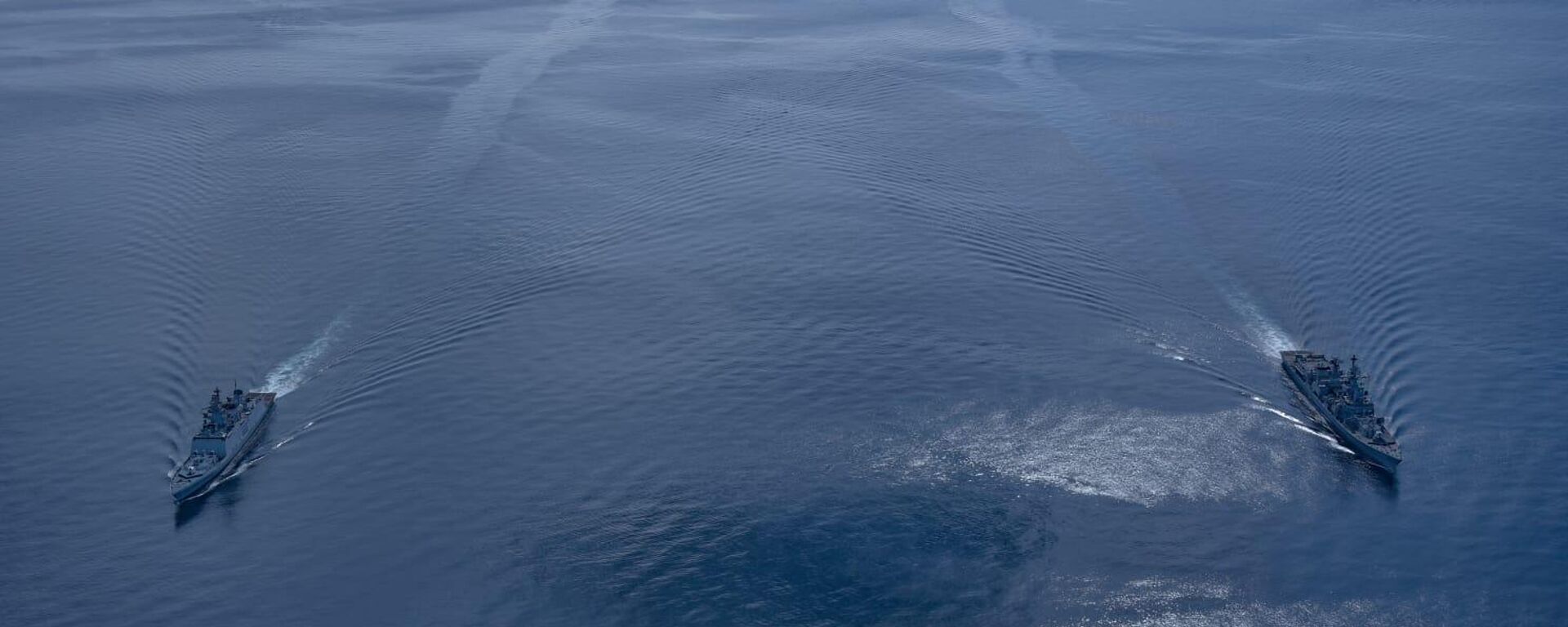https://sputniknews.in/20240308/india-falls-back-on-buddhism-to-gain-foothold-in-sub-mekong-region-6765241.html
India Falls Back on Buddhism to Gain Foothold in Sub-Mekong Region
India Falls Back on Buddhism to Gain Foothold in Sub-Mekong Region
Sputnik India
India has loaned rare Buddhist relics to Thailand for 26 days. Prime Minister Narendra Modi has described Lord Buddha's ideals as a "spiritual bridge" between India and Thailand.
2024-03-08T14:15+0530
2024-03-08T14:15+0530
2024-03-08T14:15+0530
india
asean
myanmar
narendra modi
buddha
indo-pacific
pacific ocean
russian pacific fleet
investment
trade corridor
https://cdn1.img.sputniknews.in/img/07e8/03/08/6775078_0:161:3071:1888_1920x0_80_0_0_ec1751ab1f288a2ab5730f2da3c30ee6.jpg
The exposition of the "rare relics" of Lord Buddha and his chief disciples Sariputra and Moggallana in Thailand is a very important event for millions of Thais who have come out to witness them in recent days, a leading Indian Buddhist monk has said."Buddhism is gaining followers in other Southeast Asian nations such as Indonesia, not only because of the ideals of Lord Buddha, but also because of practices such as Vipassana meditation," the Buddhist monk said.'Buddhist Diplomacy a Major Tool of India's Act East Policy'Dr K Yhome, a Senior Fellow at Asian Confluence, a Shillong-based think tank focussed on Southeast and East Asian affairs, told Sputnik India that "Buddhist diplomacy" was one of the tools that the Indian foreign policy has been using to engage with the Buddhist majority nations in the sub-Mekong region.He reckoned that "soft power alone won't help India meet its strategic goals in the region, which is located at the centre of the Indo-Pacific region."The economic component and expanding defence and military cooperation are critical for India if it seeks to bolster its presence in the region," Yhome asserted, as he noted the recent push by New Delhi to expand its cooperation after India and Association of Southeast Asian Nations (ASEAN) elevated their ties to the level of Comprehensive Strategic Partnership in 2022.Yhome noted that India and the sub-Mekong region nations, part of 'ASEAN mainland', are already cooperating in the realms of tourism, culture, education, public health, agriculture, transport and communication as well as connectivity among other areas. The six nations are part of the regional framework Mekong-Ganga Cooperation (MGC).According to official statements, most of India's bilateral trade in the region was carried out with Thailand and Vietnam. Overall, New Delhi's trade with ASEAN in 2022 amounted to over $98 billion.Why is the Lower Mekong Delta Region Crucial for Indian Interests?Yhome explained that besides the region's position at the crossroads of India and Pacific Oceans, it also served as a gateway for India's landlocked north-eastern states, which in turn are connected to India through a narrow strip of land.Yhome noted that the fate of India-Myanmar-Thailand trilateral highway, the other alternative for India to connect its north-east to the outside world, had suffered a "temporary setback" due to the fluid security situation in Myanmar."However, the project is still very much on the agenda of the Indian government and it would be materialised once the Myanmar situation is stabilised," Yhome said.Mekong Region Turning into Zone of Power PoliticsYhome said that the importance of the Mekong region to India has increased further due to intensifying great power competition between the US and China, which has also been felt in the ASEAN mainland.According to a 'Special ASEAN Investment Report 2023' released in December, Chinese companies were the biggest foreign investors in Cambodia, Laos and Myanmar. Meanwhile, the US ranked as the biggest source of foreign direct investment (FDI) in the ASEAN region."Compared to China or other powers, India's investments are miniscule," Yhome highlighted.He, however, said that India wouldn't want the region to become an "exclusive backyard" of any nation and was working with middle-powers like Japan to expand the "east-west connectivity" in the ASEAN mainland nations.
https://sputniknews.in/20230503/moving-away-from-us-china-bloc-politics-what-makes-maiden-india-asean-drills-significant-1799428.html
india
asean
myanmar
indo-pacific
pacific ocean
south china sea
bay of bengal
cambodia
vietnam
indonesia
malaysia
singapore
japan
china
bangladesh
Sputnik India
feedback.hindi@sputniknews.com
+74956456601
MIA „Rossiya Segodnya“
2024
Dhairya Maheshwari
https://cdn1.img.sputniknews.in/img/07e6/0c/13/138962_0:0:641:640_100x100_80_0_0_2cb44360dbcdf6d84bf4b299cd045917.jpg
Dhairya Maheshwari
https://cdn1.img.sputniknews.in/img/07e6/0c/13/138962_0:0:641:640_100x100_80_0_0_2cb44360dbcdf6d84bf4b299cd045917.jpg
News
en_IN
Sputnik India
feedback.hindi@sputniknews.com
+74956456601
MIA „Rossiya Segodnya“
Sputnik India
feedback.hindi@sputniknews.com
+74956456601
MIA „Rossiya Segodnya“
Dhairya Maheshwari
https://cdn1.img.sputniknews.in/img/07e6/0c/13/138962_0:0:641:640_100x100_80_0_0_2cb44360dbcdf6d84bf4b299cd045917.jpg
buddha relics in india, buddha relics in thailand, buddhism in asia, buddhism in southeast asia, buddhism in thailand, india asean trade, india asean fta, myanmar bri, india myanmar thailand highway, buddhism in india, bri projects, bri projects in laos, bri projects in mekong region, ganga mekong cooperation, lower mekong countries
buddha relics in india, buddha relics in thailand, buddhism in asia, buddhism in southeast asia, buddhism in thailand, india asean trade, india asean fta, myanmar bri, india myanmar thailand highway, buddhism in india, bri projects, bri projects in laos, bri projects in mekong region, ganga mekong cooperation, lower mekong countries
India Falls Back on Buddhism to Gain Foothold in Sub-Mekong Region
India has loaned rare Buddhist relics to Thailand for 26 days. Prime Minister Narendra Modi has described Lord Buddha's ideals as a "spiritual bridge" between India and Thailand.
The exposition of the "rare relics" of Lord Buddha and his chief disciples Sariputra and Moggallana in Thailand is a very important event for millions of Thais who have come out to witness them in recent days, a leading Indian Buddhist monk has said.
"It's very important and an emotional moment for Thais to get a chance to witness the relics," Ven Khemachara Bhikku, the deputy secretary general of New Delhi-headquartered International Buddhist Confederation (IBC), told Sputnik India.
Bhikku highlighted that Buddhism has a significant number of followers in the countries of the sub-Mekong Delta region, which include Myanmar, Laos, Cambodia, Thailand and Vietnam.
"Buddhism is gaining followers in other Southeast Asian nations such as Indonesia, not only because of the ideals of Lord Buddha, but also because of practices such as Vipassana meditation," the Buddhist monk said.
'Buddhist Diplomacy a Major Tool of India's Act East Policy'
Dr K Yhome, a Senior Fellow at Asian Confluence, a Shillong-based think tank focussed on Southeast and East Asian affairs, told Sputnik India that "Buddhist diplomacy" was one of the tools that the Indian foreign policy has been using to engage with the Buddhist majority nations in the sub-Mekong region.
"India's Buddhist heritage definitely offers it a cultural advantage as it seeks to gain a strategic foothold in the sub-Mekong region. However, I would say that the challenge for India is and has always been the issue of financing. At the end of the day, it boils down to how deep your pockets are. So, unless India backs its cultural outreach with an economic component by scaling up investments, it would be rather difficult for us to realise our strategic goals.
He reckoned that "soft power alone won't help India meet its strategic goals in the region, which is located at the centre of the Indo-Pacific region.
The sub-Mekong region is also the only land connectivity route between the two oceans, entailing a route to connect the ports of Bay of Bengal in Myanmar to Vietnamese ports at the South China Sea.
"The economic component and expanding defence and military cooperation are critical for India if it seeks to bolster its presence in the region," Yhome asserted, as he noted the recent push by New Delhi to expand its cooperation after India and Association of Southeast Asian Nations (ASEAN)
elevated their ties to the level of Comprehensive Strategic Partnership in 2022.
Yhome noted that India and the sub-Mekong region nations, part of 'ASEAN mainland', are already cooperating in the realms of tourism, culture, education, public health, agriculture, transport and communication as well as connectivity among other areas. The six nations are part of the regional framework Mekong-Ganga Cooperation (MGC).
According to official statements, most of India's bilateral trade in the region was carried out with Thailand and Vietnam. Overall,
New Delhi's trade with ASEAN in 2022 amounted to over $98 billion.
Why is the Lower Mekong Delta Region Crucial for Indian Interests?
Yhome explained that besides the region's position at the crossroads of India and Pacific Oceans, it also served as a gateway for India's landlocked north-eastern states, which in turn are connected to India through a narrow strip of land.
"The other factor is India's North-east region, which is bordered by Myanmar and China. Against the backdrop of current tensions with China, the only way to open up India's landlocked North-east region to enhance its economic connectivity with the region is either to go south or go east. So, we are witnessing India trying to
connect its northeastern states to the Bay of Bengal through Bangladesh," the Indian academic remarked.
Yhome noted that the
fate of India-Myanmar-Thailand trilateral highway, the other alternative for India to connect its north-east to the outside world, had suffered a "temporary setback" due to the fluid security situation in Myanmar.
"However, the project is still very much on the agenda of the Indian government and it would be materialised once the Myanmar situation is stabilised," Yhome said.
Mekong Region Turning into Zone of Power Politics
Yhome said that the importance of the Mekong region to India has increased further due to intensifying great power competition between the US and China, which has also been felt in the ASEAN mainland.
"China already has a first movers' advantage in the region due to its Belt and Road Initiative (BRI) investments in these countries, which are located right next-door. The BRI connectivity projects, be it roads or railways, are aimed at enhancing the north-south connectivity from China to these nations," Yhome explained.
The US, on the other hand, has often faced criticism for its perceived interference in internal affairs of some of the sub-Mekong nations such as Myanmar, Thailand and Cambodia on pretext of human rights.
According to a 'Special ASEAN Investment Report 2023' released in December, Chinese companies were the biggest foreign investors in Cambodia, Laos and Myanmar. Meanwhile, the US ranked as the biggest source of foreign direct investment (FDI) in the ASEAN region.
"Compared to China or other powers, India's investments are miniscule," Yhome highlighted.
He, however, said that India wouldn't want the region to become an "exclusive backyard" of any nation and was working with middle-powers like Japan to expand the "east-west connectivity" in the ASEAN mainland nations.



